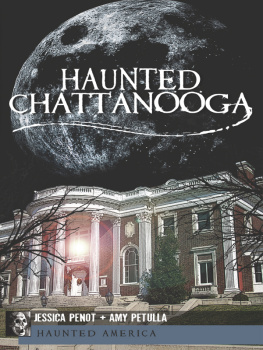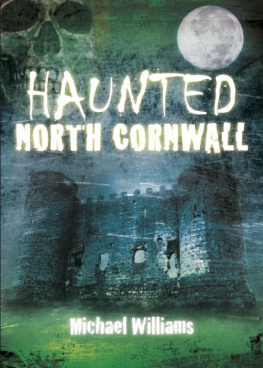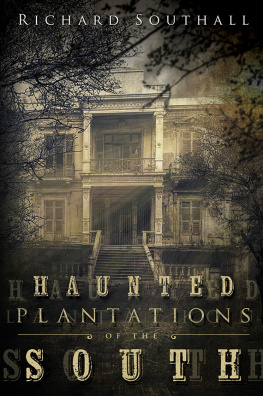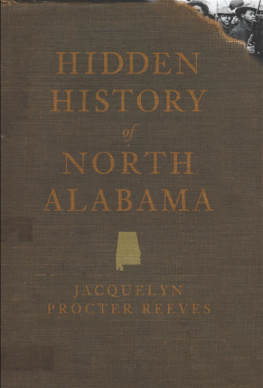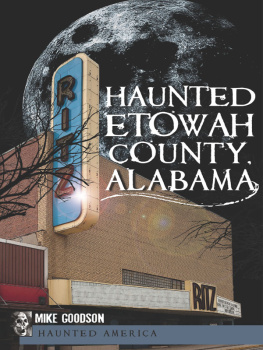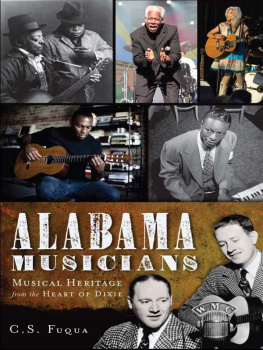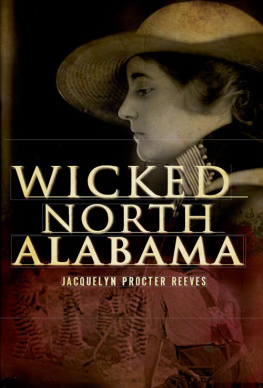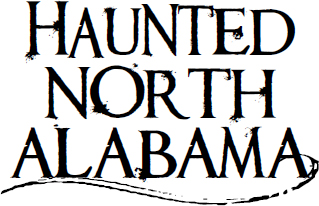

JESSICA PENOT

Published by Haunted America
A Division of The History Press
Charleston, SC 29403
www.historypress.net
Copyright 2010 by Jessica Penot
All rights reserved
Images are courtesy of the author unless otherwise noted.
First published 2010
e-book edition 2011
ISBN 978.1.61423.201.8
Library of Congress Cataloging-in-Publication Data
Penot, Jessica.
Haunted North Alabama : the phantoms of the South / Jessica Penot.
p. cm.
print edition ISBN 978-1-59629-990-0
1. Ghosts--Alabama. 2. Haunted places--Alabama. I. Title.
BF1472.U6P39 2010
133.109761--dc22
2010027410
Notice: The information in this book is true and complete to the best of our knowledge. It is offered without guarantee on the part of the author or The History Press. The author and The History Press disclaim all liability in connection with the use of this book.
All rights reserved. No part of this book may be reproduced or transmitted in any form whatsoever without prior written permission from the publisher except in the case of brief quotations embodied in critical articles and reviews.
Millions of spiritual creatures walk the Earth.
Unseen, both when we wake and when we sleep.
John Milton
CONTENTS
ACKNOWLEDGEMENTS
I had a lot of help in putting this book together. I would like to thank everyone who helped me in the process. I would especially like to thank all of those who spoke with me and told me their stories. Many of those who contributed to this book did so in confidence, and I am so grateful to have their trust. I would also like to thank those who shared their personal encounters with the supernatural with me. No matter how brief they were, they added to the flavor of the book.
I would especially like to thank the Rison-Dallas Association for sharing its stories and pictures with me. Its stories are a credit to Alabama history and can be found on the associations website: www.rison-dallas.com. I would like to thank every member of the North Alabama Paranormal Meetup who talked with me or let me listen to their stories. They are a great group of people. Leilani, from the Alabama Paranormal Association, was an amazing and invaluable help in making this book possible, and my initial interview with her led me to many of the amazing haunted locations found within this book. I would also like to thank Blair Jett of the Paranormal Research Alliance for all the information he gave me on Crybaby Hollow.
Also, thanks to Jacquelyn Procter Reeves from Huntsville Ghost Walk for all her help and advice. Thanks to every staff member at the haunted locations I visited who gave me the many off-the-record stories that made this book much more interesting. I would also like to thank my wonderful husband, Alex Penot, who went with me to explore many haunted sites, supported me through all my research and dealt with my being buried in books and papers for weeks at a time. Thanks to my wonderful sons, who were my partners in crime and traveled with me to almost every haunted location in this book. Finally, thanks to Will McKay, my editor, who found my little blog and helped me turn it into a book
INTRODUCTION
North Alabama is a beautiful and wild place tucked neatly into the rolling hills of the southern Appalachian Mountains. It spreads west into soft plains and rivers. Driving through North Alabama, there are places where you can come to believe you are the last person on earth. The trees are thick, and the undergrowth is thicker. There are many places that still havent been developed, and there are other places where the development is so thin you can imagine yourself back in the Old South. North Alabama is known for its hiking trails, its beautiful forests and its lakes and rivers. It is an outdoorsmans dream.
It is also known for its ghosts.
Trying to capture the many ghosts of North Alabama is like trying to take a single photograph that tells the story of the history of the region. Ghost stories are history and mythology delicately intertwined. By exploring the ghost stories of North Alabama, I discovered not only its past but also its present. I learned about the spirit of the region.
Most of the ghost stories contained here start in the past. They start with a tragedy and then are spread through oral tradition and folklore. Finding this folklore is harder than finding a book on history; one must travel and talk to the people who keep these histories and get them to share their stories. Of course, many dont want their names known, and many dont want to talk at all. In order to respect the privacy of the multitude of people I spoke with, I left many names out of this book.
North Alabamas history is complicated. Alabamas story began in antiquity with the natives of the land. These peoples lived in the North Alabama region for over ten thousand years. The final native inhabitants of North Alabama were the Cherokee tribe. The Cherokee people were eventually overwhelmed by a steady influx of European settlers. Many of these Europeans brought slaves with them. In his book on southern economics, Randall Miller describes these Europeans as having a culture that was rooted in the countryside. He says that their values were anti-progress, as well as honor, gentility and a highly ordered social scale. Alabama history prior to the Civil War is rooted in these values; it was the Deep South and the Old South.
Many of the ghosts found in North Alabama folklore and history are from the years that the Civil War set the South on fire. A few are from the years prior to that, when southern gentility and culture ruled. White lady ghost stories lend themselves to tragic southern belles.
White ladies are one of the many archetypes that can be found in ghost stories throughout the world. They are tragic women. They have often died violent deaths and are usually of the upper class. They are almost always described as beautiful. There are several other archetypes you might find in this collection of ghost stories. The crying child is a common theme in ghost stories and is usually associated with the death of a young child or baby. The chained man is one of the earliest archetypes and was first seen in the Middle Ages in Europe. Soldier ghosts are some of the most prevalent in the world, and this book is filled with this kind of ghost. Soldier ghosts can be found on battlefields and in forts, but they can also be found in the soldiers home, where he may linger long after his death.
Alabama history is perfect for many of these types of ghost stories. The years that followed the Civil War were filled with enough sadness and hardship to generate a book of ghost stories. Following the Civil War, North Alabama had to redefine itself economically. It had prospered when cotton was in high demand in the 1820s and 1830s, but by the Civil War, the soil was exhausted and the cotton market was flooded. North Alabama was economically crippled by the Civil War, and the plantation and agrarian economy on which it was built was no longer sustainable. During the antebellum period, North Alabama embraced change and invited manufacturers from the North to help it rebuild its broken economy. Mills flooded into Alabama and dominated the North Alabama culture and economy for many years to follow.



